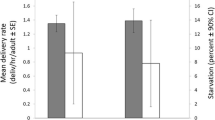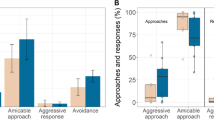Abstract
Kin-biased social tolerance among house mice has been interpreted in terms of kin discrimination. However, several lines of evidence suggest it may instead be an incidental artifact of group member discrimination. This leads to very different predictions about the social consequences of relatedness within and between social groups. Social interactions between wild-stock adult female and juvenile house mice (Mus domesticus) established in neighbouring territorial groups within enclosures reveal relatedness to dominant males within groups as the major factor determining social tolerance of juveniles by females. Relatedness to the female herself had no significant independent effect on responses indicating tolerance. Females were generally more aggressive toward neighbouring-group juveniles (all unrelated to females) compared with those from their own group (all related to females), but were most aggressive toward neighbouring juveniles sired by the neighbouring dominant male. They were also more aggressive toward their own-group juveniles that had been sired by the neighbouring dominant but only when encountered in the neighbouring territory and with a greater bias against female juveniles. Females were least aggressive toward own-group juveniles sired by their own-group dominant male. The sire-bias in tolerance among females is similar to that reported among the dominant males themselves in an earlier study. As a result of the combined sire-bias in tolerance by adult males and females, juveniles sired by their own-group dominant males become less likely to intrude into a neighbouring territory with time. Overall, the results suggest that differences in social tolerance reflect discrimination on the basis of social group membership rather than relatedness between interactants and thus provide strong experimental evidence in support of incidental kin bias rather than kin discrimination.
Similar content being viewed by others
References
Albonetti JR, D'Udine B (1986) Social experience occurring during adult life: its effects on sociosexual preferences in inbred mice, Mus musculus. Anim Behav 34:1844–1847
Aldhous P (1989a) The effects of individual cross-fostering on the development of intrasexual kin discrimination in male laboratory mice, Mus musculus L. Anim Behav 37:741–750
Aldhous P (19896) Mechanisms of apparent kin discrimination in mice. PhD thesis, University of Nottingham
Anderson PK (1961) Density, social structure and non-social environment in house mouse populations and the implication for the regulation of numbers. Trans NY Acad Sci 23:447–451
Anderson PK (1970) Ecological structure and gene flow in small mammals. Symp Zool Soc Lond 26:229–325
Baker AEM (1981a) Gene flow in house mice: behavior in a population cage. Behav Ecol Sociobiol 8:83–90
Baker AEM (1981b) Gene flow in house mice: introduction of a new allele into free-living populations. Evolution 35:243–288
Barnard CJ (1990) Kin recognition: problems, prospects and the evolution of discrimination systems. Adv Stud Behav 19:29–81
Barnard CJ (1991) Kinship and social behaviour: the trouble with relatives. Trends Ecol Evol 6:310–312
Barnard CJ, Aldhous P (1990) Kinship, kin discrimination and mate choice. In: Hepper P (ed) Kin recognition. Cambridge University Press, Cambridge, pp 123–147
Barnard CJ, Fitzsimons J (1988) Kin recognition and mate choice in mice: the effects of kinship, familiarity and social interference on intersexual interaction. Anim Behav 36: 1078–1090
Barnard CJ, Hurst JL, Aldhous P (1991) Of mice and kin: the functional significance of kin bias in social behavior. Biol Rev 66: 379–430
Berry RJ (1981) Population dynamics of the house mouse. Symp Zool Soc Lond 47:335–395
Blaustein AR, Bekoff M, Daniels TJ (1987) Kin recognition in vertebrates (excluding primates): empirical evidence. In: Fletcher DJC, Michener CD (eds) Kin recognition in Animals. Wiley, New York, pp 287–331
Boyse EA. Beauchamp GK, Yamazaki K (1987) The genetics of body scent. Trends Genet 3:97–102
Bronson FH (1979) The reproductive ecology of the house mouse. Q Rev Biol 54:265–299
Connor JL, Lynds PG (1977) Mouse aggression and the intruder familiarity effect: evidence for multi-factor determination. J Comp Physiol Psychol 91:270–280
Crowcroft P, Rowe FP (1963) Social organization and territorial behaviour in the wild house mouse (Mus musculus L). Proc Zool Soc Lond 140:517–531
DeLong KT (1978) Population ecology of feral house mice. Ecology 48:611–634
Fletcher DJC, Michener CD (eds) (1987) Kin recognition in animals. Wiley, New York
Grafen A (1990) Do animals really recognize kin? Anim Behav 39:42–54
Grafen A (1991) Kin vision. Anim Behav 41:1085–1087
Hepper P ed (1990) Kin recognition. Cambridge University Press, Cambridge
Hurst IL (1987) Behavioural variation in wild house mice (Mus domesticus Rutty): a quantitative assessment of female social organization. Anim Behav 35: 1846–1857
Hurst JL (1988) A system for the individual recognition of small rodents at a distance, used in free-living and enclosed populations of house mice. J Zool Lond 215:363–367
Hurst JL (1990a) Urine marking in populations of wild house mice (Mus domesticus Rutty). 1. Communication between males. Anim Behav 40:209–222
Hurst JL (1990b) Urine marking in populations of wild house mice (Mus domesticus Rutty). 11. Communication between females. Anim Behav 40:223–232
Hurst JL (1990c) Urine marking in populations of wild house mice (Mus domesticus Rutty). 111. Communication between the sexes. Anim Behav 40:233–243
Hurst JL (1993) The priming effects of urine substrate marks on interactions between male house mice, Mus musculus domesticus Schwarz and Schwarz. Anim Behav 45:55–81
Hurst JL, Barnard CJ (1992) Kinship and social behavior in wild mice: effects of social group membership and relatedness on the responses of dominant males toward juveniles. Behav Ecol 3: 196–206
Hurst JL, Fang J, Barnard CJ (1993) The role of substrate odours in maintaining social tolerance between male house mice, Mus musculus domesticus. Anim Behav 45:997–1006
Hurst JL, Fang, J, Barnard CJ (1994) The role of substrate odours in maintaining social tolerance between male house mice (Mus musculus domesticus): relatedness, incidental kinship effects and the establishment of social status. Anim Behav 48:157–167
Kareem AM (1983) Effect of increasing periods of familiarity on social interactions between male sibling mice. Anim Behav 31: 919–926
Kareem AM, Barnard CJ (1982) The importance of kinship and familiarity in social interactions between mice. Anim Behav 30: 594–601
König B (1989) Behavioural ecology of kin recognition in house mice. Ethol Ecol Evol 1:99–110
Kimelman BR, Lubow RE (1974) The inhibitory effect of pre-exposed olfactory cues on inter-male aggression in mice. Physiol Behav 12:919–922
Mackintosh JH (1981) Behaviour of the house mouse. Symp Zool Soc Lond 47:337–365
Manning CJ, Wakeland EK, Potts WK (1992) Communal nesting patterns in mice implicate MHC genes in kin recognition. Nature 360:581–583
Meddis R (1984) Statistics using ranks: a unified approach Blackwell, Oxford
Poole TB, Morgan HDR (1975) Aggressive behaviour of male mice (Mus musculus) towards familiar and unfamiliar opponents. Anim Behav 37:638–644
Reimer JD, Petras ML (1967) Breeding structures of the house mouse (Mus musculus) in a population cage. J Mammal 48: 88–99
Wilkinson GS, Baker AEM (1988) Communal nesting among genetically similar mice. Ethology 77:103–114
Yamazaki K, Boyse EA, Mike V, Thaler HT, Mathieson BJ, Abbott J, Boyse J, Zayas ZA, Thomas L (1976) Control of mating preferences in mice by genes in the major histocompatibility complex. J Exp Med 144:1324–1335
Author information
Authors and Affiliations
Additional information
Communicated by G. Wilkinson
Rights and permissions
About this article
Cite this article
Hurst, J.L., Barnard, C.J. Kinship and social tolerance among female and juvenile wild house mice: kin bias but not kin discrimination. Behav Ecol Sociobiol 36, 333–342 (1995). https://doi.org/10.1007/BF00167794
Received:
Accepted:
Issue Date:
DOI: https://doi.org/10.1007/BF00167794




